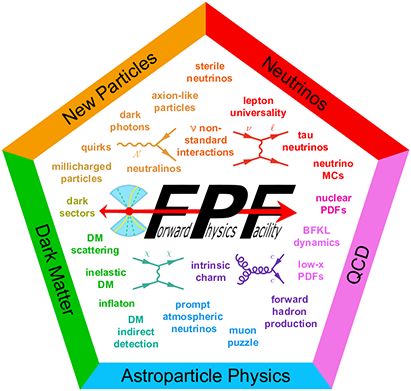The Large Hadron Collider (LHC) at CERN is the highest energy particle collider currently operating. It started running in 2008, but is scheduled to enter a new High-Luminosity LHC (HL-LHC) phase in 2029 and run until the 2040's. A key goal in the field of particle physics is to make sure the discovery potential of the HL-LHC is fully realized.
The Forward Physics Facility (FPF) is a proposed new underground cavern at the LHC that will host a suite of far-forward experiments during the HL-LHC era. The existing large LHC detectors have un-instrumented regions along the beam line, and so miss the physics opportunities provided by the enormous flux of particles produced in the far-forward direction. Without the FPF, the HL-LHC will be blind to neutrinos and many proposed new particles. However, small pathfinder experiments currently operating in the far-forward region at the LHC, including FASER and SND@LHC, have recently directly observed collider neutrinos for the first time and demonstrated the potential for world-leading sensitivity to new physics. With the FPF, a diverse suite of experiments will help the LHC realize its full potential by detecting thousands of TeV neutrinos every day (the highest energy neutrinos detected from a human source), expanding our understanding of proton and nuclear structure and the strong interactions to new regimes, clarifying astroparticle data, and carrying out world-leading searches for light dark matter, dark sectors, and many other new particles.
The FPF physics program spans many frontiers and will greatly enhance the LHC’s physics program through to its conclusion in the 2040s. Work on the FPF is supported by the CERN Physics Beyond Collider (PBC) group, and the science case for the FPF has been developed in dedicated FPF meetings and through numerous Snowmass working groups, including the Energy, Neutrino Physics, Rare Processes and Precision, Cosmic, and Theory Frontiers. The opportunities have been summarized in a 80-page review and a more comprehensive 430-page Snowmass White Paper, written and endorsed by 400 physicists.
The FPF is well aligned with the recommendations of recent high-level community studies:
- Our highest immediate priority accelerator and project is the HL-LHC, including the construction of auxiliary experiments that extend the reach of HL-LHC in kinematic regions uncovered by the detector upgrades. — Snowmass 2021 Energy Frontier Report
- The full physics potential of the LHC and the HL- LHC should be exploited. — 1st recommendation of the 2020 European Strategy Update
The FPF requires no modifications to the LHC and will support a sustainable experimental program, requiring no additional energy for the beam beyond the existing LHC program. In addition, as a mid-scale project composed of smaller experiments that can be realized on short and flexible timescales, the FPF will provide a multitude of scientific and leadership opportunities for junior researchers, who can make important contributions from construction to data analysis in a single graduate student lifetime.
